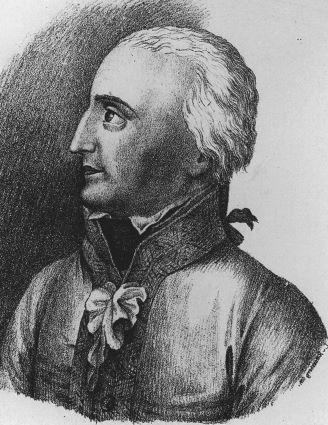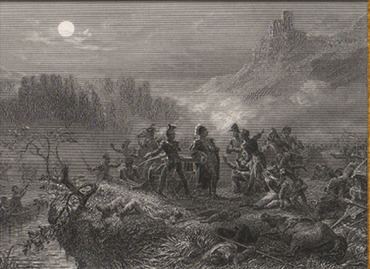Allegiance Habsburg Monarchy Name Johann von | Died November 11, 1805 | |
 | ||
Service/branch Chief of the Quartermaster General Staff of the Army Rank Lieutenant Field Marshal Similar People Edouard Mortier - duc de Tr, Honore Theodore Maxime, Mikhail Miloradovich, Dmitry Dokhturov, Mikhail Kutuzov | ||
Heinrich Schmitt (1743 – 11 November 1805) rose to the rank of Feldmarshalleutnant Lieutenant-General in the Habsburg military during the French Revolutionary and Napoleonic wars.
Contents
- Family and education
- Military career
- Service in the French Revolutionary Wars
- Recall to active duty
- Death at Drenstein
- Assessment and legacy
- References

He developed a sound military reputation as a surveyor, map-maker, and strategist during Austria's wars with the Ottoman Empire, He served on the Quartermaster's staff during the War of the First Coalition. As a major general, he was one of Archduke Charles trusted advisers during the War of the Second Coalition campaign in southwestern Germany.
In 1799, his reputation was tarnished by the assassination of the French delegates to the Congress of Rastatt in 1799, and he retired the following year. When war broke out again in 1805, he was recalled from retirement and assigned to the combined Russian-Austrian forces on the Danube. On 11 November, Schmitt was killed by friendly fire at the Battle of Dürenstein.
Family and education
Heinrich Schmitt was born in 1743, the son of Johann Sebastian von Schmitt, a Rittmeister (cavalry captain) in the Imperial Cuirassier Regiment Graf Cordova. Schmitt may have been born in Pest (Budapest) in Hungary, or, as other sources claim, in Bavaria. In 1742–43, his father's regiment participated in the Battle of Sahay, and then in the Siege of Prague, followed by duty in Bavaria and the Rhineland in 1743. His father died in 1752—it is unclear where—and on 25 June 1758, at the age of 14 years, Schmitt enrolled in the Imperial School of Engineering in Gumpendorf. There he received a thorough technical training in engineering and the extensive education provided for officers on all other major subjects, particularly those pertaining to war and science.
After three years, on 15 November 1761, Schmitt received a commission a Fähnrich (ensign) in Infanterie-Regiment Nr. 15 Pallavicini. During his assignment with this regiment, he saw service in the last years of the Seven Years' War (1765–1763) in the Bohemian theatre. The lack of accurate maps had hampered the conduct of the Seven Years' War and, in 1764, Schmitt was assigned to a project to improve the map-making capacity of the military. The idea of the scientific soldier, or a soldier educated in the specifics of military operations, led to an investment in the training and education of officers. The development of map making, and Carlos Pallavicini was at the forefront of this movement. On 1 February 1769, after proving himself capable in this assignment, he was promoted to Oberleutnant (Lieutenant) and transferred to the reorganized General-Quartermaster staff.
Military career
From 1769 to 1778, Schmitt was assigned to the Turkish border areas, and was especially active in Temesvar, in the Banat, bordering the Ottoman Empire. In 1778, he was promoted to captain and mobilized against Prussia during the short War of the Bavarian Succession, after which he transferred back to the Balkan border areas, where he stayed until 1782. His thorough knowledge of the country guaranteed him map-making and intelligence assignments in Turkish-occupied Bosnia to gather information in preparation for an upcoming new war against Turkey. In particular, he developed material on the Turk's military situation. His work on the development of intelligence of Turkish strength in Osijek and Alt Gradiska satisfied his superiors and when the war actually broke out in 1787, he was assigned to the General Staff of the Slavonion Corps. He participated in the storming of the fortress at Šabac, in Serbia, on 24 April 1788. Emperor Joseph II promoted him personally to major on 14 May 1788. In 1789, Schmitt fought at the Siege of Belgrade, and on 23 February 1790, he was promoted to lieutenant colonel. In March 1790, he transferred to Bohemia, under command of Field Marshal Ernst Gideon von Laudon, for anticipated action against the Kingdom of Prussia. When this war came to naught, he was transferred to the Austrian Netherlands in 1791, to help contain a local uprising.
Service in the French Revolutionary Wars
At the outbreak of the War of the First Coalition against France in April 1792, Schmitt was a staff officer in the main Imperial army in the Austrian Netherlands. He distinguished himself in the defense of the pass of the Croix-aux-Bois (14 September 1792) and in the battles of Raismes and Vicoigne on (both on May 8, 1793). On 3 September 1793, after his promotion to colonel, he served under Field Marshal Prince Josias of Saxe-Coburg-Saalfeld. In the autumn of 1794, Schmitt organized the retreat of the main Imperial Army, now under the command of Coburg's successor, Feldzeugmeister Count Clerfayt from their untenable positions in the Austrian Netherlands eastward to the Rhine.
In the campaign of 1795, still serving under Field Marshal Count Clerfayt, he was appointed to the staff of Archduke Charles by Emperor Francis II in April 1796. Working alongside his deputy, Anton Mayer von Heldensfeld, Schmitt, now an Oberst colonel and Chief of Staff to Archduke Charles planned the basis of the famous 1796 campaign, which produced the Imperial victories at the Battle of Amberg (24 August 1796) and the Battle of Würzburg (2 September 1796), which gained him promotion to Generalmajor on 6 September 1796.
The trust the Archduke placed in Schmitt was briefly interrupted in 1799 when he was connected, by rumor, to the 29 April assassination of the French delegates to the Congress of Rastatt. The assassination occurred as the delegation was leaving the city. The official investigation into the assassination placed enormous pressure on Schmitt, to such an extent that he briefly resigned as Charles' Chief of Staff, but he was quickly reinstated. On 1 March 1800, Schmitt was promoted to Feldmarschallleutnant, but later in that year, the Archduke was himself replaced as commander-in-chief by Field Marshal Pál Kray. Although Schmitt remained on Kray's staff, he again requested retirement, claiming he was tired and could no longer cope with the stress of the job. In reality, he and Kray's Quartermaster General, Generalmajor Johann Gabriel Chasteler de Courcelles, seldom saw eye-to-eye on any of the main issues facing the army and Kray relied more on Chasteler than on Schmitt. His request was initially refused, but on 19 August 1800, Emperor Francis II approved the petition when Kray seconded it. Schmitt went first to Vienna and then Hostitz at Kromeriz, near Brno. There he lived with his old friend Ferdinand Ritter von Geißlern until 1805.
Recall to active duty
During the War of the Third Coalition in 1805–1806, Schmitt returned from retirement to active service. Equipped with a glowing letter of endorsement from Emperor Francis II to the Russian Infantry General Mikhail Illarionovich Kutuzov (1745–1813), Schmitt arrived at the Russian headquarters and was appointed Chief of the Quartermaster General Staff of the Allied Army. Schmitt met with the Russian forces at the great abbey by Melk, on the Danube, and he and the commanders concocted a plan to encircle Édouard Mortier's French force near Dürenstein. To do so, they drew not only on their own military experience, but called upon a captain from the region, to use his geographic and local knowledge.
Death at Dürenstein
Édouard Mortier had marched from Passau and Linz toward Vienna, traveling on the north bank of Danube. His newly created VIII Corps, known as Corps Mortier, consisted of three divisions, which were stretched 56 kilometers (35 mi) apart along the river between Marbach and Dürenstein. This over-extension left his Corps' northern flank unprotected, against Napoleon's specific instructions. Schmitt's plan capitalized on this mistake. On 11 November 1805, Kutuzov's column trapped one of Mortier's divisions, under command of Honoré Théodore Maxime Gazan de la Peyrière. The Russians used a ruse to entice Gazan into an attack on a small force, and then trapped him between two columns. The French were surrounded at the front and rear by the Russians, caught on the flood plain at Dürenstein. They could neither move forward nor backward. A second French division arrived in mid-afternoon and attacked the Russians in the flank, but were themselves surprised when Schmitt led an additional Russian column out of the mountains. Gazan's division lost over 40 percent of its men, colors, and several guns. The battle lasted well into the night. In its waning moments, the French were evacuating across the Danube in a flotilla of boats. In the dark confusion, Schmitt was shot, probably by Russian musketry, in a field between the Waldstein and Heudürrgraben. Wilhelm von Kotzebue, a German in Russian service, later reported that the column came through the forest road and entered the main road on the river's edge; they immediately entered the cross-fire between Dupont's forward posts of Dragoons and the Dokhtoruv's Russians. He fell by Wadstein, and was buried on the battlefield with the dead of his Russian column. Although his burial site has never been found, a monument for him was erected in a park in nearby Krems in 1811.
Assessment and legacy
One of history's great Chiefs of Staff and a key member of the Imperial Staff, Schmitt was the most experienced Austrian leader, called out of retirement for this specific task of organizing the Austro-Russian retreat. He had wide experience as a leader: From the summer of 1796 until his retirement in 1800, he had been Chief of the Quartermaster General Staff of the Army, of the Lower Rhine, the Rhine, and the Army of Germany, and a trusted member of Archduke Charles' staff. Consequently, he had organized a variety of maneuvers and battle plans under different terrain. The military historian Digby Smith hypothesizes that Schmitt, an experienced officer and sound tactician, would have been more effective at the Battle of Austerlitz, at least more effective than his replacement, Franz von Weyrother, as Chief of the Quartermaster General Staff of the Allied Army. After Schmitt's death, Weyrother, the architect of the Austrian defeat at Hohenlinden, developed the general battle plan of the Allied action at Austerlitz. In the long run, it was unlikely that Schmitt's plan would have changed the overall outcome—Austerlitz was arguably one of Napoleon's finest battles—but his battle plan would no doubt have been an improvement over the one the Allies used.
Schmitt never married. He was known for his bright intellect, his composure, and his innate courage. Heinrich Schmitt was, in his time, recognized as one of the best and most distinguished officers of the Imperial Austrian army.
